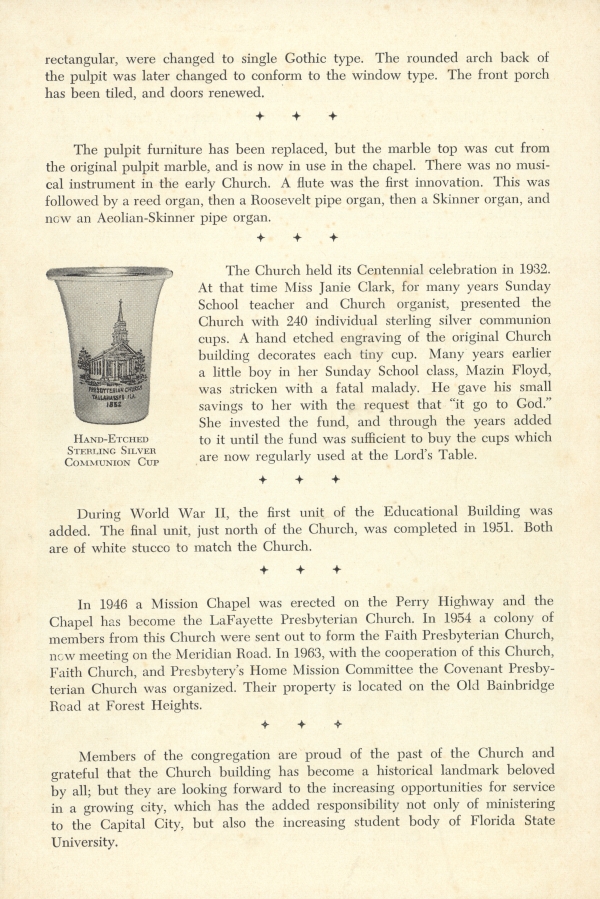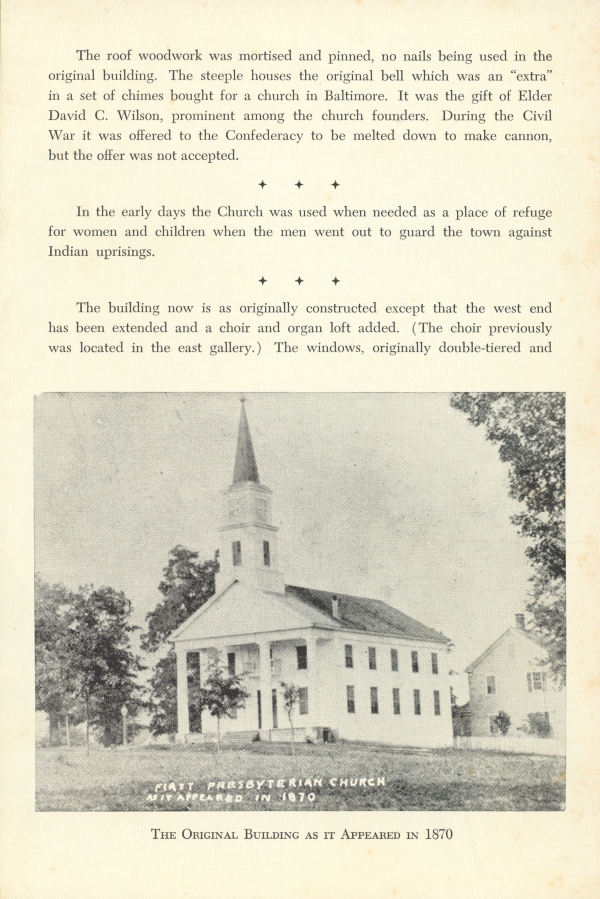Florida Memory is administered by the Florida Department of State, Division of Library and Information Services, Bureau of Archives and Records Management. The digitized records on Florida Memory come from the collections of the State Archives of Florida and the special collections of the State Library of Florida.

State Archives of Florida
- ArchivesFlorida.com
- State Archives Online Catalog
- ArchivesFlorida.com
- ArchivesFlorida.com
State Library of Florida
Related Sites

Description of previous item
Description of next item

Pamphlet entitled "An Historical Sketch of the First Presbyterian Church, Tallahassee, Florida"
Source
Description
Date
Format
Coverage
Topic
Geographic Term
The pulpit furniture has been replaced, but the marble top was cut from the original pulpit marble, and is now in use in the chapel. There was no musical instrument in the early Church. A flute was the first innovation. This was followed by a reed organ, then a Roosevelt pipe organ, then a Skinner organ, and now an Aeolian-Skinner pipe organ.
[photo] Hand-Etched Sterling Silver Communion Cup
The Church held its Centennial celebration in 1932. At that time Miss Janie Clark, for many years Sunday School teacher and Church organist, presented the Church with 240 individual sterling silver communion cups. A hand etched engraving of the original Church building decorates each tiny cup. Many years earlier a little boy in her Sunday School class, Mazin Floyd, was stricken with a fatal malady. He gave his small savings to her with the request that "it go to God." She invested the fund, and through the years added to it until the fund was sufficient to buy the cups which are now regularly used at the Lord's Table.
During World War II, the first unit of the Educational Building was added. The final unit, just north of the Church, was completed in 1951. Both are of white stucco to match the Church.
In 1946 a Mission Chapel was erected on the Perry Highway and the Chapel has become the LaFayette Presbyterian Church. In 1954 a colony of members from this Church were sent out to form the Faith Presbyterian Church, now meeting on the Meridian Road. In 1963, with the cooperation of this Church, Faith Church, and Presbytery's Home Mission Committee the Covenant Presbyterian Church was organized. Their property is located on the Old Bainbridge Road at Forest Heights.
Members of the congregation are proud of the past of the Church and are grateful that the Church building has become a historical landmark beloved by all; but they are looking forward to the increasing opportunities for service in a growing city, which has the added responsibility not only of ministering to the Capital City, but also the increasing student body of Florida State University.
Title
Source
Date
Format
Language
Type
Identifier
Coverage
Geographic Term
Thumbnail
Display Date
ImageID
topic
Transcript
of the
FIRST PRESBYTERIAN CHURCH
TALLAHASSEE, FLORIDA
The Church Building in 1952
In 1824, Governor Duval, by proclamation located the capital of the Territory of Florida at the site which has become the City of Tallahassee. When the Legislative Council convened in the fall of 1826, a Presbyterian Minister, Reverend Henry White, was appointed Chaplin and given permission to hold preaching services each Sabbath while the Assembly was in session in the partially constructed wing of the capitol building. The structure was torn down in 1839 and the present capitol was begun.
From 1827 through 1831 the records of the Board of National Missions of the Presbyterian Church show home missionaries assigned to this field, and a Sunday School organized. Late in 1832 the Reverend Joseph Stiles, Horace Pratt and Nathaniel Pratt, a committee from the Georgia Presbytery, held a "protracted meeting" and on November 4, 1832 organized a Presbyterian Church composed of two Ruling Elders and sixteen members. It was placed under the temporary care of Hopewell Presbytery. On February 16, 1833 the Church was incorporated by act of the Territorial Council. In June 1835 the congregation asked for bids to erect a brick building 68 ft. x 48 ft. The building was finished three years later and dedicated to the Lord on Sunday, May 13, 1838. Financing of the Church was by the sale of pews, the lowest bid being $125.00, the total pew sales $12,500. The final building costs totaled $13,370.60. The pews of mahogany, with doors, were later replaced by the present pews.
The timber used in the building was of heart pine. Some idea of its quality can be gained from the table top in the entry of the Church. This top was the original entrance door sill, hollowed out by the passage of many feet through the years, and now squared up and preserved as a historical piece in the form of a table.
Pillars supporting the galleries were hand-hewed and show the adze marks if one looks closely. The north gallery was reserved by the trustees' deed for slaves who attended the services. They were admitted to membership.
In the early days the Church was used when needed as a place of refuge for women and children when the men went out to guard the town against Indian uprisings.
The building now is as originally constructed except that the west end has been extended ans a choir and organ loft added. (The choir previously was located in the east gallery.) The windows, originally double-tiered and
[photo]
The Original Building as it Appeared in 1970
The pulpit furniture has been replaced, but the marble top was cut from the original pulpit marble, and is now in use in the chapel. There was no musical instrument in the early Church. A flute was the first innovation. This was followed by a reed organ, then a Roosevelt pipe organ, then a Skinner organ, and now an Aeolian-Skinner pipe organ.
[photo] Hand-Etched Sterling Silver Communion Cup
The Church held its Centennial celebration in 1932. At that time Miss Janie Clark, for many years Sunday School teacher and Church organist, presented the Church with 240 individual sterling silver communion cups. A hand etched engraving of the original Church building decorates each tiny cup. Many years earlier a little boy in her Sunday School class, Mazin Floyd, was stricken with a fatal malady. He gave his small savings to her with the request that "it go to God." She invested the fund, and through the years added to it until the fund was sufficient to buy the cups which are now regularly used at the Lord's Table.
During World War II, the first unit of the Educational Building was added. The final unit, just north of the Church, was completed in 1951. Both are of white stucco to match the Church.
In 1946 a Mission Chapel was erected on the Perry Highway and the Chapel has become the LaFayette Presbyterian Church. In 1954 a colony of members from this Church were sent out to form the Faith Presbyterian Church, now meeting on the Meridian Road. In 1963, with the cooperation of this Church, Faith Church, and Presbytery's Home Mission Committee the Covenant Presbyterian Church was organized. Their property is located on the Old Bainbridge Road at Forest Heights.
Members of the congregation are proud of the past of the Church and are grateful that the Church building has become a historical landmark beloved by all; but they are looking forward to the increasing opportunities for service in a growing city, which has the added responsibility not only of ministering to the Capital City, but also the increasing student body of Florida State University.
Chicago Manual of Style
Pamphlet entitled "An Historical Sketch of the First Presbyterian Church, Tallahassee, Florida". 1960 (circa). State Archives of Florida, Florida Memory. <https://www.floridamemory.com/items/show/297288>, accessed 4 November 2025.
MLA
Pamphlet entitled "An Historical Sketch of the First Presbyterian Church, Tallahassee, Florida". 1960 (circa). State Archives of Florida, Florida Memory. Accessed 4 Nov. 2025.<https://www.floridamemory.com/items/show/297288>
AP Style Photo Citation

 Listen: The World Program
Listen: The World Program

